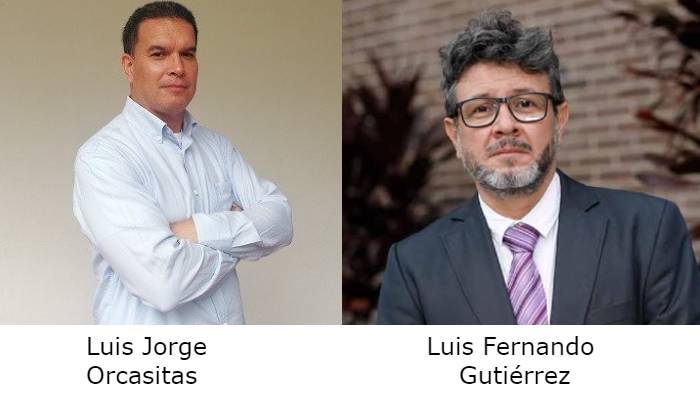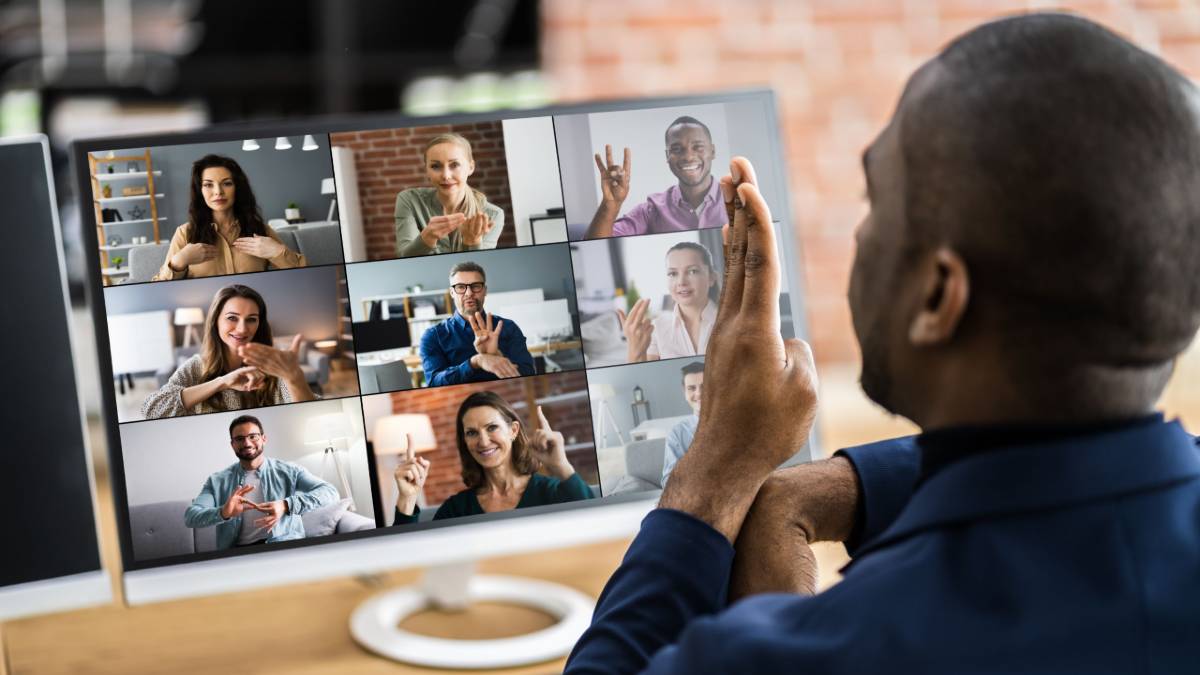We spoke with the authors of a recently published book on accessibility to public television for the hearing and visually impaired population.
Richard Santa
In recent years, television regulators in Latin America have set their sights on how to make the medium more accessible to people with visual and hearing disabilities, driven by the implementation of digital television. In that sense, they have issued rules that oblige channels to have available closed caption, subtitles, among other solutions, aimed at this population.
In this context, Luis Fernando Gutiérrez, PhD, and PhD candidate Luis Jorge Orcasitas, two professors and researchers at the Universidad Pontificia Bolivariana, with great experience in academia and the media, have just published the book "Accessibility of digital television for people with sensory disabilities", based on the experience of public television channels in Medellín, Colombia, and with an international context.
The two authors told TVyVideo+Radio, a magazine of which they are regular columnists, how the research process was, the main conclusions and recommendations recorded in the book.
TVV: Why did you decide to investigate accessibility on television?
Authors: We did research at the Faculty of Social Communication to propose a master's degree in digital television. We realized that from the technical, technological point of view, this new system allowed or at least glimpsed a possibility of incorporating people who, perhaps, in analog television had been a little removed from the medium. Among those are people with sensory, visual and hearing disabilities.
Historically, this type of population in Colombia has been excluded, if we talk about accessibility and inclusion. They are not easily accessible communities, there are also many prejudices on the part of researchers, it was a very interesting challenge and allowed us to get rid of many prejudices.
TVV: When did you start and how long did you take doing this research? Authors: The project was presented in 2014. Between 2016 and 2017 fieldwork was done. In 2018 we began to write the book with the results of fieldwork and documentary research. It was hard work, a fairly robust book in terms of content and the editorial process, which is also a complex process due to the demands of the University's publishing house, which includes external juries. The book was published at the end of 2022.
Authors: The project was presented in 2014. Between 2016 and 2017 fieldwork was done. In 2018 we began to write the book with the results of fieldwork and documentary research. It was hard work, a fairly robust book in terms of content and the editorial process, which is also a complex process due to the demands of the University's publishing house, which includes external juries. The book was published at the end of 2022.
TVV: How large is the population with sensory disabilities in Medellín?
Authors: It's a pretty complex question to answer. Official information is from the last national census conducted in 2005, which includes people with disabilities. The organizations that work with this population say that the Census figures provided by DANE do not agree with figures that other organizations such as the National Institute of the Deaf Insor or the National Institute of the Blind INCI have.
In the book we talk about the Ministry of Health, which is another of the institutions that is responsible for assessing data on the number of people with disabilities in Colombia, reported in 2017 23.3% of people who have difficulties with the nervous system, 13.8% with visual difficulty. In short, there are no exact figures.
TVV: From the law, how much is protected for people with sensory disabilities to guarantee their access to the media?
Authors: The research work includes a tracking of all the laws, regulations, international agreements that Colombia has signed, the Accessibility Law. The Colombian Constitution is explicit in protecting and including people with disabilities, not only the media but in general everything that is the State to facilitate their access to a decent quality of life.
With specific regard to audiovisual media, there are guidelines and standards but, from our point of view, they remain insufficient, especially in public channels. In Medellín and Antioquia there are two public channels that subsist with State resources
TVV: From television channels, are there initiatives to improve accessibility for people with sensory disabilities, beyond what is required by law?
Authors: Having a 24-hour programming with sign language interpreter or audio description, with closed caption and audio description, are millionaire figures for the channels that work, above all, with money from the Fund for the Promotion of Public Television.
There is an interrelation, the educational part, the social part of these communities is interrelated with the media apparatus. For example, a deaf person who has sign language as his first language, does not know how to read and the medium puts a closed caption, that person will not be able to have an inclusion in the middle. If the hours of programming with language, with sign language interpreter does not reach 60% of the programming, these people will be excluded from 40% or 50%, half of the programming will not be able to enjoy it. Not to mention blind people, who have no audio description.
TVV: Did you analyze the experience of other countries that have already fully adopted digital television and the experience with aids for people with sensory disabilities?
Authors: Yes, it was an arduous crawl. We were based in countries of the European Union, the United States, Canada, the United Kingdom. In Latin America we were able to track especially the regulations in Mexico, Bolivia, Venezuela, Peru, Argentina and Brazil. Our perception is that Brazil is one of the somewhat more advanced countries in the area, along with Mexico.
Developed countries obviously have a great advantage in terms of accessibility services. For example, in the United States the law is categorical, strict, rigorous and channels have to comply with sign language, closed caption, audio description, yes or yes. The same happens in the United Kingdom, and in some countries of the European Union. Spain is a very special case because it has very strong institutions that promote the development of technologies and implementation for this population.
TVV: How accessible are the television channels in Medellín, the city under investigation? Authors: In Medellín, at the time of the study, there were four local channels, two public, Teleantioquia and Telemedellín, one semi-private that has since disappeared and another private. What did we find? Who know the regulations very well and strictly adhere to the norm. If the rule tells you that 20% of the programming must have closed caption they meet that minimum, neither less nor more. Same with sign language. One of the main factors is the economic factor, because of the costs of implementing these solutions.
Authors: In Medellín, at the time of the study, there were four local channels, two public, Teleantioquia and Telemedellín, one semi-private that has since disappeared and another private. What did we find? Who know the regulations very well and strictly adhere to the norm. If the rule tells you that 20% of the programming must have closed caption they meet that minimum, neither less nor more. Same with sign language. One of the main factors is the economic factor, because of the costs of implementing these solutions.
In the research we found that this has a lot to do with the strength of the community itself and it definitely seems, at least from the pressure they have made and from what they have achieved from the point of view of regulation and normative, that the deaf community is much stronger than the blind community in that sense.
TVV: How used are solutions such as audio description of audiovisual content on digital TV, sign language and subtitling on television in Medellín?
Authors: The use of audio description is unprecedented in the country because this system is not yet there, it does not have a standard, it is not regulated, it is not incorporated into the television system. There is no audio description in Colombia. Definitely, what is most used by the current regulations are Colombian sign language interpreter and closed caption. Even for the closed caption most, if not all, devices have that service simply with a button.
TVV: How much do the disabled population in Medellín know and use these solutions?
Authors: From the experience in the research work, this community knows and uses, above all, the sign language interpreter. It is the most common for them in the accessibility service, because many of this population does not know how to read the Spanish language, it is not their first language. If they put the service of closed caption or subtitling, and you can not read Spanish, nothing is done. That service is being lost.
However, the sign language interpreter service does, they use a lot, although not all programming is covered with the service. Even them, one of the suggestions or requests they make is that in the short term the service is 100% of the programming. But some channels say that this is not aesthetic, that it does not contribute to the visual part of the material. There we would have to make a balance between the urgent, the immediate and the necessary, and it seems to me personally that it is necessary to incorporate this service throughout the programming grid.
TVV: Where is the book?
Authors: The book is an ebook version. It is located in the institutional repositor of the Universidad Pontificia Bolivariana. You only have to enter the portal of the UPB, UPB library and in the review of the catalog of the library you can find the book Accessibility of digital television for people with sensory disabilities in Medellín Colombia or you can also consult by the surnames of the authors Orcasitas Pacheco Luis and Gutiérrez Cano Luis Fernando.


























Leave your comment